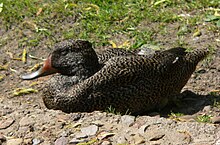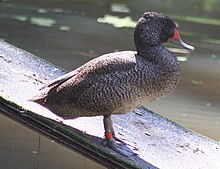Monkey duck
| Monkey duck | ||||||||||
|---|---|---|---|---|---|---|---|---|---|---|

Monkey Duck ( Stictonetta naevosa ), male |
||||||||||
| Systematics | ||||||||||
|
||||||||||
| Scientific name of the genus | ||||||||||
| Stictonetta | ||||||||||
| Reichenbach , 1853 | ||||||||||
| Scientific name of the species | ||||||||||
| Stictonetta naevosa | ||||||||||
| ( Gould , 1841) |
The freckled duck ( Stictonetta naevosa ), sometimes monkeys goose or dots duck called, is a bird art from the family of ducks (Anatidae). It is the only species of its own subfamily Stictonettinae and occurs exclusively in Australia. The monkey duck looks more like a duck due to its rather short legs, but is more closely related to the real geese and swans for morphological reasons .
The IUCN classifies the monkey duck as not endangered ( least concern ). The population is estimated at 11,000 to 26,000 sexually mature individuals.
Appearance
Monkey ducks reach a body length of 51 to 56 centimeters, the wingspan is 77 to 82 centimeters. The sexual dimorphism is not very pronounced. Males are generally slightly larger and weigh an average of 980 grams, while females weigh 840 grams. The beak in the female is completely slate gray, the male develops a bright reddish beak base in the breeding season . Both sexes usually have an inconspicuous gray-brown spotted plumage with scattered small white spots. Adult monkey ducks go through the full moult after brood has ended. The small plumage is also molted towards the end of the dormant period.
Newly hatched chicks of the monkey duck are solid gray. On the ventral side and under the wings, the plumage is bright and almost white. The upper beak is gray-blue and becomes almost blue towards the base. The nail is pink, the mandible is pale red. The feet are blue-gray, the webbed feet are brownish, and the iris is dark brown. Fledglings are similar to adults, but are lighter throughout. The light brown or white spots in adults are clay-yellow in them. It is unusual for ducks that the young birds mature at the age of 6 months.
Typical behaviors
Monkey ducks are often seen in flocks. During the day, they often rest on sand and mud banks or on logs or rocks lying in the water. Resting monkey ducks often adopt a very upright posture, with the head tucked under the wings.
Swimming monkey ducks lie very high in the water. They only dive when cleaning their plumage or when trying to escape a predator. On land they are very agile, but when they run they have the swaying body movement that is typical for many ducks. When flying out of the water, they need a short run-up and usually only gain height slowly. In flight they flap their wings very quickly, the neck is stretched far forward. Monkey ducks are generally not very happy to shout.
Possible confusion
The monkey duck can hardly be confused with any other species due to its uniform plumage and body structure in the area of distribution. In terms of size, the monkey duck corresponds to the eyebrow duck and the Australian bog duck and can be confused with both species in poor visibility. The monkey duck can be distinguished from the eyebrow duck mainly by the lack of any color markings on the head. The Australian bog duck also has a largely uniformly colored plumage. It differs in the rounder head profile, the brown color of its plumage and the light beak bandage. Males of the Australian bog duck also have very light eyes. In flight, the white underwings of Australian bog ducks are clearly visible.
The down chicks of the monkey ducks can be confused with those of the mute swan and the pied swan . The chicks of the monkey duck, however, are a bit darker and have a bluish, not black, beak. A black stripe also runs from the beak to the eyes of the pied swan chicks.
distribution and habitat
The monkey duck is a duck bird of the temperate climatic zone and occurs only in southeastern Australia and southwestern Australia, in drought years also in coastal areas. Odd guests also occasionally reach Tasmania. Their habitat is swamp and marshland rich in vegetation, flooded bushland and coastal lagoons. The banks of the waters where monkey ducks occur are often densely overgrown with wire bushes , casuarines , love grasses , leptospermum and myrtle heaths .
In the dry season, monkey ducks wander around unsteadily in small groups and then also find themselves on larger lakes with a water surface of more than 100 hectares, where several hundred individuals gather. If there is extensive inland flooding due to heavy rainfall, these regions are populated very quickly. After such years, there is often a significant increase in the population.
food
The diet consists mainly of algae and components of aquatic plants , but also of zooplankton , worms, insects and even small fish . Since monkey ducks only scoop but do not dive while foraging, they usually stay in water zones less than 0.7 meters deep. However, it typically resides in the shallow water zone. When acquiring food, the monkey duck sifts through the water of every puddle while walking forward with a sideways pendulum movement of its head, or plows through the surface of the water with its beak while swimming in order to take up floating food.
Reproduction
Monkey ducks are predominantly monogamous birds, but the pair bond exists only for a short time. In captive monkey ducks, some evidence has also been found that some monkey ducks are polygamous. It is considered likely that this behavior will also occur in the wild. Monkey ducks are not territorial, males occasionally defend the immediate vicinity of their nest and females occasionally defend the immediate vicinity of their offspring.
The breeding season is determined by the periodic rainfall and usually ranges from June to December. Nests are located in the shallow water area in the swamp vegetation, between alluvial plant material. Occasionally, however, they also use the abandoned coot nests . The nest is built by the male, while the incubation and rearing of the young, which takes about a month, is the sole responsibility of the female. Males usually leave the female during the first week of brood. They then pair with another female. Occasionally, the males will re-mate with the first female when the chicks are at least forty days old and the habitat conditions allow a second brood to be raised.
A monkey duck's clutch usually contains between five and seven eggs. In captive monkey ducks, it has been observed that females occasionally lay eggs in other monkey ducks' nests. Monkey ducks lay around one egg a day, the clutch is incubated for around 28 days, and the females often start brooding before the last egg is laid.
The chicks are reared in the shallow water along muddy river banks. There the chicks swim and wade, and also dig in the shallow water, looking for the finest food particles. You will be able to fly by around nine weeks.
Protection status

The species is now considered endangered because of hunting, but primarily because of the disappearance of its habitat. It is protected in Australia, but is occasionally shot because it is mistaken for eyebrow ducks and white throated ducks . The monkey duck is particularly endangered during the hunting season because large numbers of them are limited to relatively few bodies of water during this time. Monkey ducks that fly up are also slow to gain height. During the long dry season from 1979 to 1983, at least 4.5 percent of the population was shot despite the protection status. For this reason, in the Australian state of Victoria, as early as the 1980s, waters with a high population of monkey ducks were excluded from hunting. Since 1989, applicants for hunting licenses have also had to pass a test to determine how far they can differentiate between the individual species of duck.
Systematics
The monkey duck is reminiscent of the swimming duck in many ways . This is mainly due to their short legs. However, it is placed in a family of its own because it has many primitive features that are not found in the swimming ducks. These include the simply structured vocal head , the non-shimmering plumage, the almost complete lack of sexual dimorphism , the structure of the tarsi and in particular the raised beak.
The classification of the monkey duck within the duck bird family is controversial. Some authors have placed them near the whistling geese . Others see a relationship to the Anatinae , the rowing ducks or the Kasarkas . However, it is mostly classified as a distant relative of the geese and swans. A recent form within the duck birds is missing. However, the red base of the beak may suggest a distant relationship to the cuckoo duck.
attitude
The monkey duck was not one of the water fowl kept in Europe until late in the 20th century. In Australia, the world's first breeding succeeded only in 1985 with monkey ducks raised from collected eggs. Their attitude is relatively widespread in Australia. The Wildfowl and Wetlands Trust became the first establishment outside Australia to receive two females and one male in 1985, which the Trust was able to breed with for the first time in 1992. As early as 1993, 23 young birds grew up there.
supporting documents
literature
- PJ Higgins (Ed.): Handbook of Australian, New Zealand & Antarctic Birds , Volume 1, Ratites to Ducks, Oxford University Press, Oxford 1990, ISBN 0195530683
- Janet Kear (Ed.): Ducks, Geese and Swans . Oxford University Press, 2005, ISBN 0-19-854645-9
- Hartmut Kolbe; Die Entenvögel der Welt , Ulmer Verlag 1999, ISBN 3-8001-7442-1
Web links
- Stictonetta naevosa in the endangered Red List species the IUCN 2008. Posted by: BirdLife International, 2008. Accessed on December 18 of 2008.
- Videos, photos and sound recordings of Stictonetta naevosa in the Internet Bird Collection
- BirdLife factsheet on the monkey duck
Individual evidence
- ↑ BirdLife factsheet on the monkey duck , accessed April 24, 2011
- ^ Higgins, p. 1161
- ↑ Kolbe, p. 90
- ↑ Kolbe, p. 91
- ↑ Higgins, p. 1161 and p. 1162
- ^ Higgins, p. 1161
- ^ Higgins, p. 1162
- ^ Higgins, p. 1163 and p. 1164
- ^ Higgins, p. 1164
- ^ Higgins, p. 1164
- ↑ Higgins, p. 1167
- ^ Higgins, p. 1164
- ^ Higgins, p. 1170
- ^ Higgins, p. 1162
- ↑ a b Kear, p. 339
- ↑ Kolbe, p. 91



